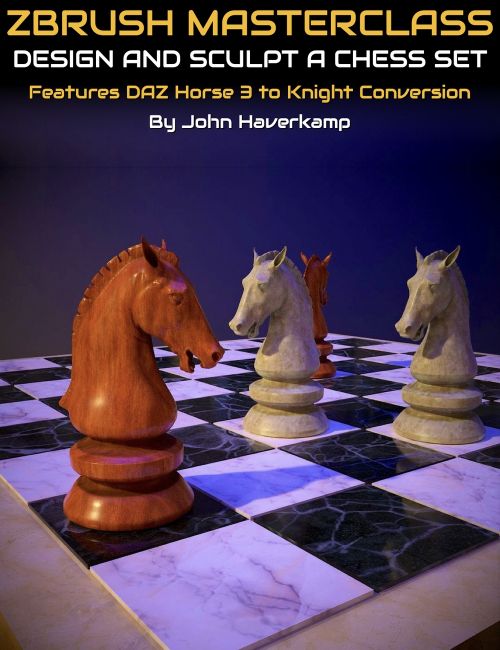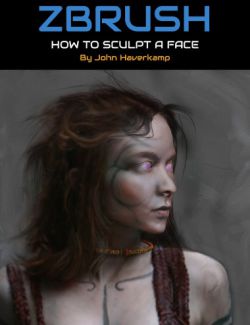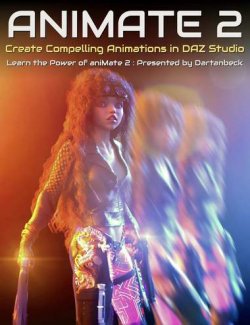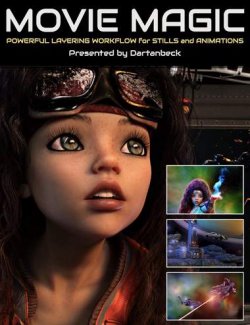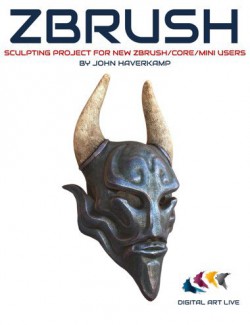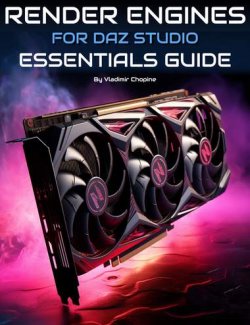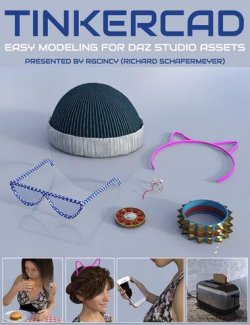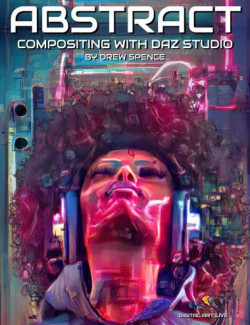Chess has always been a source of fascination, not just for its intricate gameplay but also for its beautifully designed pieces, each with its own story, form, and significance. Now, through the lens of ZBrush, we’re offering you a unique opportunity to breathe life into these iconic forms.
Whether you’re a DAZ 3D content creator, a budding digital sculptor or a seasoned artist looking to diversify your portfolio, this video tutorial set by John Haverkamp will enrich your ZBrush journey. Dive deep into the world of design principles with sculpting and detailed texturing as you learn to craft a series of chess pieces, including transforming the DAZ 3 Horse into a Knight. To complete the project, John also shows you how to create a chessboard.
Improve your ZBrush sculpting skills so that you can:
- Master the intricacies of design principles, enhancing your artistic vision and creating consistent, captivating chess pieces.
- Elevate your ZBrush skills by learning advanced sculpting and texturing techniques, setting you apart as a proficient and versatile digital artist.
- Develop a unique and personal style that resonates through your entire chess set, making every piece a work of art.
Unlock the secrets to crafting exquisite chess pieces with ZBrush, a leading digital sculpting tool. This comprehensive tutorial series guides you through the creation process, equipping you with the skills to:
John Haverkamp is going to show you a guide to sculpting chess pieces in ZBrush so that you can:
- Understand the significance of historical sculpting styles and apply them to digital creations.
- Utilize advanced ZBrush features for intricate modeling.
- Create detailed, game-ready chess pieces with final level texturing and finishing.
This tutorial product is for you if you are in one of these situations:
- a) An aspiring or professional digital artist looking to hone your sculpting skills.
- b) A traditional sculptor transitioning to digital and seeking to replicate physical textures
- c) A game developer or 3D modeler aiming to add finely crafted objects to your portfolio.
3. This is for you if you want to accomplish:
- Crafting a set of chess pieces with individual character and style.
- Learning the end-to-end process of digital sculpting, from initial block out to final texture baking.
4. John is going to show you how to understand ZBrush's robust toolset...Even if you:
- Have limited experience with digital sculpting tools.
- Struggle with the transition from physical to digital art forms.
- Are new to ZBrush and its complex array of features.
Product Overview:
This tutorial series is crafted to guide both novices and more experienced sculptors through the nuanced process of digital chess piece creation. The sessions are structured to progressively build your skills, allowing you to:
- Master the foundational techniques of primitive-based sculpting.
- Understand and apply advanced features like live booleans, shadowbox, and polygroups.
- Enhance your sculptures with detailed textures and realistic finishes using Substance Painter.
- Tackle complex UV mapping and topology optimization for a professional outcome.
Recommended Experience to Utilize this Tutorial Set:
- Basic knowledge of the ZBrush user interface is required for this tutorial set
- Recommended for beginners and intermediate level ZBrush users
- Substance Painter and Marmoset are also used and mentioned
- Video format and running time
- 5 hours and 22 minutes
- Four videos recorded in HD 1920 x 1080 MP4 format
- Includes searchable library of these videos : any keyword or phrase can be searched for across all four videos.
Sample Video
Presenter : John Haverkamp- Proven Experience with ZBrush
John Haverkamp was born in Ohio and then moved to the pristine Blue Ridge Mountains of Virginia at a young age. There, he spent a semi-isolated childhood re-enacting the Lord of the Rings and being corrupted by Dungeons and Dragons. Always with the fondness for the fantastical and medieval, art school drove him deeper into Luddite territory by granting him the skills of a traditional metal-smith. This meant post-college jobs making copper fountains, welding and steel fabricating, casting and finishing bronze sculptures, and working for an architectural blacksmith throughout his twenties.
Digitally, John got sucked into cyberspace and the arcane mysteries of 3D studio max. The perfect software match for John was Zbrush, which he discovered over 15 years ago. Now, he teaches digital arts and ZBrush, constantly endeavoring to improve his craft as a digital sculptor and visualizer through personal work, illustration, and indie game projects.
What's Included and Features
- ZBrush Masterclass : Design and Sculpt a Chess Set
- Video 1 : 1 hour and 22 minutes (.MP4)
- 00:00:00 Introduction to the session, focusing on the Lewis chess pieces and the significance of historical sculpting styles.
- 00:03:00 Discussion on various sculpting styles and digital resources for sculptors. Introduction to basic primitive-based sculpting in ZBrush.
- 00:06:00 Instruction on using Creative Commons licensed models for educational purposes in ZBrush, using a Thunder God and Child Demon model as an example.
- 00:09:00 Walkthrough of sculpting a Lewis Chessman, starting with simple geometric shapes, emphasizing the importance of the blockout stage.
- 00:12:00 Continuation of sculpting, focusing on refining shapes and adding complex elements like the sword and shield.
- 00:15:00 Further detailing of the chess piece, especially the head and helmet, highlighting the utility of primitive blockouts.
- 00:18:00 Development of arms and their positioning, with tips on using ZBrush tools for effective modeling.
- 00:21:00 Completion of the first blockout stage and introduction to detailed sculpting techniques, particularly for the shield and sword.
- 00:24:00 Explanation of the extraction process for the shield and sword, focusing on adjustments for accuracy and style.
- 00:27:00 Polishing the extracted shapes, ensuring alignment with the overall sculpture, and discussing historical accuracy in sculpting.
- 00:30:00 Fine-tuning arm positions and emphasizing the importance of precise adjustments in digital sculpting.
- 00:33:00 Refinement of sword and hand details, including tips on using masking and polygroups in ZBrush.
- 00:36:00 Detailed adjustments to the sword and introduction of the sword guard, focusing on authenticity.
- 00:39:00 Finalizing the sword guard and discussing the benefits of primitives for concepting sculptures.
- 00:42:00 Transition to head and helmet details, with adjustments for shape and proportion
- 00:45:00 Merging elements into a single sculpture for further detailing and discussing the DynaMesh process.
- 00:48:00 Introduction of clay buildup and smoothing techniques for further refinement of the sculpture.
- 00:51:00 Detailing facial features, emphasizing simplicity and style, and the versatility required in professional sculpting.
- 00:54:00 Continued detailing, focusing on refining elements like the sword, shield, and facial features.
- 00:57:00 Techniques for creating crisp lines and angles using various ZBrush brushes.
- 01:00:00 Further detailing of the sculpture, including shoulder pads and DynaMesh process for refining details.
- 01:03:00 Emphasis on the importance of silhouette in design and the flexibility of different software for blockout stages.
- 01:06:00 Introduction of a wolf sculpture as a teaching example, with tips on blocking out complex shapes.
- 01:09:00 Demonstration of how expression changes can alter a sculpture's personality, leveraging a strong blockout foundation.
- 01:12:00 Discussion of traditional vs. digital sculpting limitations, using a dragon sculpture as an example.
- 01:15:00 Techniques for enhancing textures and details, including masking by color and using the contrast slider.
- 01:18:00 Use of the extractor brush to create custom alphas from scanned textures, summarizing the advantages of digital sculpting.
- Video 2 : 1 hour and 24 minutes (.MP4)
- 00:00:00 Overview of incorporating DAZ models into ZBrush for chess knight creation, with early steps like separating eyes for individual sculpting.
00:03:00 Techniques for processing DAZ mesh, including mesh part separation and polygroup setup for efficient ZBrush sculpting.
00:06:00 Adjusting the horse head for symmetry and using mirror and weld for consistent modeling in ZBrush.
00:09:00 Fixing issues with DAZ horse mouth lining using ZBrush's smooth brush modifiers.
00:12:00 Creating poly loops in ZBrush for mesh modification control, particularly for mesh tear correction.
00:15:00 Designing the chess piece base, discussing topology considerations with trim brushes in ZBrush.
00:18:00 Using ZModeler brush for mesh editing and highlighting the importance of clean geometry in sculpting.
00:21:00 Starting horse head design for the chess piece, integrating DAZbase mesh with geometric shapes.
00:24:00 Benefits of working with separate objects for form visualization and correction ease in ZBrush.
00:27:00 Using radial symmetry in ZBrush for balanced and appealing chess piece design.
00:30:00 Adjustments to the horse head and chess piece parts, utilizing various sculpting techniques.
00:33:00 Merging parts of the chess piece and discussing DynaMesh blending in ZBrush.
00:36:00 Refining the chess piece sculpture, focusing on blending and smoothing transitions.
00:39:00 Use of creases and subdivision in ZBrush for sharp edge and detail preservation.
00:42:00 Introduction to curve lathe tool in ZBrush for precise lathe shape creation.
00:45:00 Continuation with the curve lathe tool, ensuring alignment and symmetry.
00:48:00 Emphasizing interactive design in ZBrush and changes to the chess piece's lower part.
00:51:00 Addressing mesh integrity and refining details, especially preserving sharp edges.
00:54:00 Importance of overall design and form before detailed anatomy sculpting.
00:57:00 Analyzing classical sculptures for stylized anatomy, using the Horse of Selene as reference.
01:00:00 Comparing realistic and stylized horse anatomy, highlighting artistic choices in sculpting.
01:03:00 Techniques for sculpting expressive horse anatomy.
01:06:00 Detailing horse anatomy, focusing on silhouette and gestural lines.
01:09:00 Refining gestural forms and adding details, emphasizing smooth transitions.
01:12:00 Approach to DynaMesh resolution and importance of resolving details before subdividing.
01:15:00 Use of the smooth stronger brush for high-poly meshes and detailing process.
01:18:00 Demonstrating ZRemesher workflow for good topology and addressing projection errors.
01:21:00 Conclusion emphasizing saving work before complex operations in ZBrush and anticipation for participants' work.
- 00:00:00 Overview of incorporating DAZ models into ZBrush for chess knight creation, with early steps like separating eyes for individual sculpting.
- Video 3 : 1 hour and 20 minutes (.MP4)
- 00:00:00 Introduction to ZBrush's advanced features, focusing on the split screen tool and learning from a polar bear model on Sketchfab.
- 00:03:00 Techniques for mimicking physical textures digitally. Utilizing split screen for comparative sculpting in ZBrush.
- 00:06:00 Use of shadow box feature in ZBrush for converting objects into modeling information.
- 00:09:00 Demonstrating infinite depth for silhouette changes and AccuCurve for sharp angles in ZBrush.
- 00:12:00 Tips on learning sculpture by mimicking, using subtraction and trim dynamic tool in ZBrush.
- 00:15:00 Process of creating a blank for sculpting and using various brushes for refinement.
- 00:18:00 Discussing thick skin feature in ZBrush and its application in sculpting techniques.
- 00:21:00 Using the build up brush, focusing on subtractive sculpting techniques in ZBrush.
- 00:24:00 Emphasizing the importance of primary and secondary forms before adding detailed textures.
- 00:27:00 Comparing effects of different sculpting techniques, showcasing realism and detail differences.
- 00:30:00 Using smooth brush with modifiers for diverse texture effects on sculptures.
- 00:33:00 Utilizing live booleans in ZBrush for complex shapes and dynamic designs.
- 00:36:00 Customizing ZBrush interface and setting up hotkeys for efficient sculpting.
- 00:39:00 Introduction to radial symmetry for sculpting, especially for chess pieces.
- 00:42:00 Using live booleans for accurate sculpting reference, aligning 3D and 2D models.
- 00:45:00 Refining and smoothing sculpted objects, focusing on sharp edge maintenance.
- 00:48:00 Tips for using dynamesh and live booleans together for detailed sculptures.
- 00:51:00 Managing complex projects in ZBrush using folders and booleans.
- 00:54:00 Demonstrating deformers in ZBrush for shape manipulation in sculpting.
- 00:57:00 Finalizing booleans and the importance of saving work and original models for edits.
- 01:00:00 Using shadowbox for transforming sculpts into carvings, adjusting resolution and polish.
- 01:03:00 Setting up visibility counts and folders in ZBrush for managing multiple objects.
- 01:06:00 Efficient sculpting techniques in ZBrush, including big brushes for shaping and dynamesh for resolution.
- 01:09:00 Use of Sculptris Pro for detailed sculpting and creating holes in models.
- 01:12:00 Techniques for sculpting realistic cloth folds using various brushes in ZBrush.
- 01:15:00 Discussing sculpting drapery and fabric, focusing on linear flow and directionality.
- 01:18:00 Tips for sculpting classical drapery, using gravity in ZBrush for natural fabric sag.
- Video 4 : 1 hour and 16 minutes (.MP4)
- 00:00:00 Introduction to hard surface modeling in ZBrush for a chessboard, focusing on the Initialization menu and QCube for grid creation.
- 00:03:00 Techniques for polygroup setup and using ZModeler brush for detailed chessboard tile design.
- 00:06:00 Exploring polygroup and QMesh settings for creating a chessboard border and discussing border size design.
- 00:09:00 Adjusting polygroups for the chessboard surface and sides, finalizing geometry with ZBrush tools.
- 00:12:00 Tips on using creasing and dynamic subdivision for refining the chessboard model in ZBrush.
- 00:15:00 Addressing challenges in creasing and UV mapping for optimal ZBrush modeling results.
- 00:18:00 Detailed explanation of the crease subdivision workflow in ZBrush, focusing on beveling effects.
- 00:21:00 Preparing the chessboard for texturing in Substance Painter, including model export steps.
- 00:24:00 Demonstrating UV unwrapping in ZBrush and examining texture application efficiency.
- 00:27:00 Discussing UV mapping challenges in Substance Painter and ZBrush's automatic UV limitations.
- 00:30:00 Exploring Modo for UV manipulation and the importance of accurate UVs in texturing.
- 00:33:00 Exporting and baking textures in Substance Painter, addressing map errors and distance issues.
- 00:36:00 Continuing to troubleshoot texture baking in Substance Painter with different settings.
- 00:39:00 Concept of separating mesh for distinct baking processes in Substance Painter.
- 00:42:00 Attempting separate baking of mesh components, focusing on ZBrush topology challenges.
- 00:45:00 Revising the original model for better topology and UV efficiency in ZBrush.
- 00:48:00 Adjusting polygroups and creases for improved UV unwrapping and texturing layout.
- 00:51:00 Further UV mapping adjustments, addressing automatic unwrapping issues in ZBrush.
- 00:54:00 Using Modo for advanced UV processing and achieving desired UV layouts.
- 00:57:00 Completing UV mapping in Modo and updating the model in ZBrush, addressing poly paint and mesh issues.
- 01:00:00 Troubleshooting UV export methods and mesh replacement in ZBrush.
- 01:03:00 Setting up UDIMs in Modo for chessboard UV arrangement in separate tiles.
- 01:06:00 Finalizing UV layout in Modo for efficient Substance Painter texturing.
- 01:09:00 Applying textures to different UV tiles in Substance Painter for a marble effect.
- 01:12:00 Overview of UV tricks for texturing and planning future sessions on related topics.Documentation: (.PDF)
- Searchable version of tutorial set (ZBrushChessSearchableVersion.PDF)
- PDF document with link to searchable version of tutorial set.
Install Types:
DazCentral, DIM, Manual Install
